|
Riding the Range with
Cowboy Collectibles
by Bob Brooke
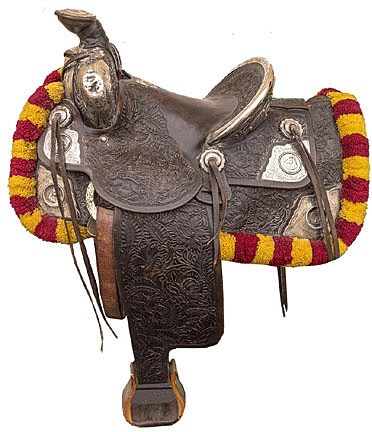 Elaborately
carved saddles, jingling silver spurs, Stetson hats, leather chaps,
saddles—all are part of cowboy memorabilia. Inspired by the
pistol-packing ranch hands who rode the open range or became bronco
busters in rodeos or hailed from Hollywood, these artifacts have been
collected since the 1980's and are part of a craze now sweeping the
country. Elaborately
carved saddles, jingling silver spurs, Stetson hats, leather chaps,
saddles—all are part of cowboy memorabilia. Inspired by the
pistol-packing ranch hands who rode the open range or became bronco
busters in rodeos or hailed from Hollywood, these artifacts have been
collected since the 1980's and are part of a craze now sweeping the
country.
The cowboy has been a pop-culture image for more than a 100 years. And
today cowboy culture is hot. Some say it was the stories of Zane Grey,
but actually it was the T.V, cowboys— The Lone Ranger, Hopalong Cassidy,
Gene Autry, Roy Rogers and Dale Evans—that had the greatest impact.
Most working cowboys were itinerant and poor until World War I. By
necessity they limited their possessions to what would fit in their
saddlebags.
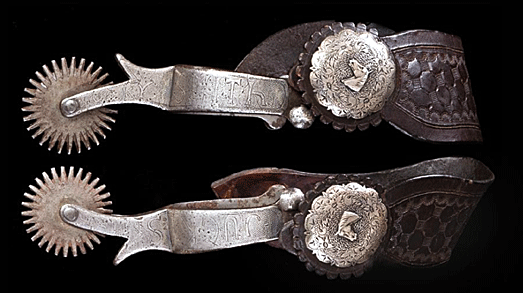
Compared to the plain
boots and cookie-cutter-like spurs that working cowboys have long
preferred, the trappings of the Wild West shows were positively
flamboyant. A pair of chaps, probably worn in a Wild West show, are
embellished with tacks depicting hearts, spades, diamonds and clubs and
splashed with large orange spots. The price is $15,000.
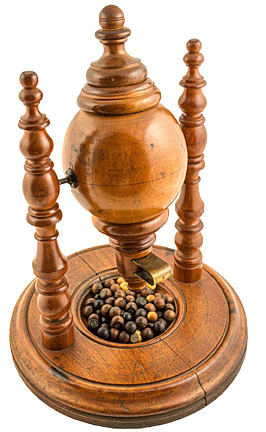 But
cowboy collectibles reach far beyond the working trappings of the cowboy
to include photographs, advertising, books, gambling devices and motion
picture memorabilia. A poster for a Wild West show starring a man who
called himself Kit Carson is priced at $1,000. A pair of life-size
composition-board cowboy silhouettes from a 1950's amusement park are
priced at $5,000. A Bible with a Remington vest-pocket pistol concealed
inside—most likely a stage prop—is $4,500, and a Hopalong Cassidy clock
with the hero and his horse depicted on the face is $750. But
cowboy collectibles reach far beyond the working trappings of the cowboy
to include photographs, advertising, books, gambling devices and motion
picture memorabilia. A poster for a Wild West show starring a man who
called himself Kit Carson is priced at $1,000. A pair of life-size
composition-board cowboy silhouettes from a 1950's amusement park are
priced at $5,000. A Bible with a Remington vest-pocket pistol concealed
inside—most likely a stage prop—is $4,500, and a Hopalong Cassidy clock
with the hero and his horse depicted on the face is $750.
Heavily corroded rifles, pistols and revolvers, also called dug-ups,
have increased in price over the last five years from about $300 to more
than $1,000 a piece.
The cowboy as pop culture was dramatically advanced in dime novels and
Wild West shows by the turn of the century. By then the real cowboy was
becoming more and more of a myth, and the pop cowboy was becoming the
reality.
Spurs
Spurs are metal tools designed to be worn in pairs on the heels of
riding boots for the purpose of directing a horse or other animal to
move forward or laterally while riding. Riders use them to refine their
commands to their horse.
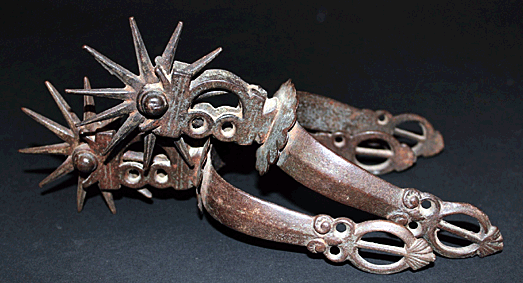
Spurs are usually held on by a leather strap that goes over the arch of
the foot and under the sole in front of the boot heel. Some western
designs have a leather strap that goes only over the top, with a heel
chain or a rubber "tiedown" instead of a strap under the boot. Also,
some styles have no straps, where the heel band is simply very tight and
slips on wedged between the sole and heel of the boot. Some spur designs
have a slot for running the spur strap through, others have "buttons",
sometimes on the heel band itself and sometimes attached to the heel
band by hinges that allow a strap with buttonholes to be attached.
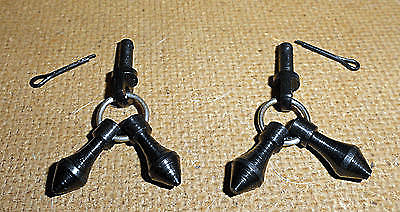 Spurs
seen in western riding may also have small curved-up hooks on the shank
in front of the rowel, called "chap guards,” that were originally used
to prevent the rider's chaps from interfering with the rowels—spinning
stars—of the spur. The shank angle from the yoke can vary from "full" to
"one half" to "one quarter" to "straight". Some cowboys also added small
metal pajados, also known as jingle bobs, near the rowel, to create a
jingling sound whenever the foot moved. Rowels can vary in size and
number of points. Spurs
seen in western riding may also have small curved-up hooks on the shank
in front of the rowel, called "chap guards,” that were originally used
to prevent the rider's chaps from interfering with the rowels—spinning
stars—of the spur. The shank angle from the yoke can vary from "full" to
"one half" to "one quarter" to "straight". Some cowboys also added small
metal pajados, also known as jingle bobs, near the rowel, to create a
jingling sound whenever the foot moved. Rowels can vary in size and
number of points.
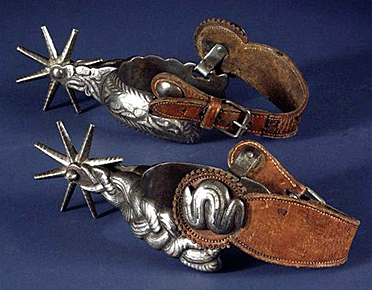 Though
often decorated throughout history, in the 15th century spurs became an
art form in both decoration and design, with elaborate engraving, very
long shanks, and large rowels. The elaborate designs reflected the
increased abundance of precious metals, particularly silver, that
followed the European exploration of the Americas that began in 1492.
Spur designs in Spain and colonial Mexico were particularly elaborate.
For example, the spurs of the Spanish conquistadores were sometimes
called espuela grande, the "grand spur", and could have rowels as large
as six inches around. Though
often decorated throughout history, in the 15th century spurs became an
art form in both decoration and design, with elaborate engraving, very
long shanks, and large rowels. The elaborate designs reflected the
increased abundance of precious metals, particularly silver, that
followed the European exploration of the Americas that began in 1492.
Spur designs in Spain and colonial Mexico were particularly elaborate.
For example, the spurs of the Spanish conquistadores were sometimes
called espuela grande, the "grand spur", and could have rowels as large
as six inches around.
Elaborate spur designs persisted, particularly in the Americas,
especially in Mexico and the western United States, where spurs had
become an integral part of the vaquero and cowboy traditions. Western
riders still wear silver spurs with elaborate engravings.
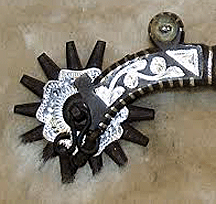 Each
area of the southwest developed it's own style of spur and several
designs for came about made from different metals from plain iron to
pure silver. Eventually just about no cowboy in the west would be seen
without a set of spurs on, it wasn’t only a status symbol but a cowboy
was considered "naked" without them. Many a cowboy spent the cold winter
nights in the bunkhouse hammering out his own set of spurs and working
on a pair of straps. The spur was used not only in the breaking of
horses but gained popularity in the wild west shows, rodeos when riding
a wild bronco, and various other rodeo events. Spur straps came in
several styles and the designs went from plain to the highly ornate,
with or without conchos and/or studs. Each
area of the southwest developed it's own style of spur and several
designs for came about made from different metals from plain iron to
pure silver. Eventually just about no cowboy in the west would be seen
without a set of spurs on, it wasn’t only a status symbol but a cowboy
was considered "naked" without them. Many a cowboy spent the cold winter
nights in the bunkhouse hammering out his own set of spurs and working
on a pair of straps. The spur was used not only in the breaking of
horses but gained popularity in the wild west shows, rodeos when riding
a wild bronco, and various other rodeo events. Spur straps came in
several styles and the designs went from plain to the highly ornate,
with or without conchos and/or studs.
Chaps
The Spanish introduced chaps as away to protect their legs from cactus,
thorns, and brush. They called them "Chaparehos" which meant leather
breeches or "leg of iron." The first chaps were just large pieces of
cowhide attached to the saddle and wrapped around the legs.
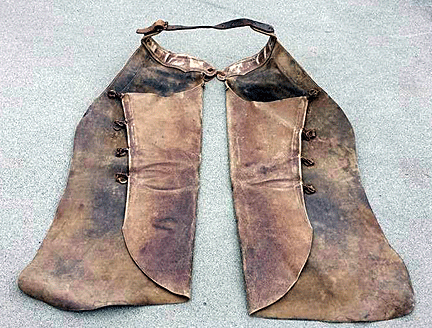 Later
the vaqueros modified this design by making a legging that hung from a
belt around the waist and went down the leg to just below the knee and
rawhide thongs would hold the chaps to the legs. Early pioneer Texans
designed a heavy buckskin breech that fully encircled the leg and often
had fringing. Chasing longhorns that would run into dense thickets of
thorns necessitated heavy protection. Later
the vaqueros modified this design by making a legging that hung from a
belt around the waist and went down the leg to just below the knee and
rawhide thongs would hold the chaps to the legs. Early pioneer Texans
designed a heavy buckskin breech that fully encircled the leg and often
had fringing. Chasing longhorns that would run into dense thickets of
thorns necessitated heavy protection.
As the cowboy population grew throughout the west, western leather
makers designed three types of chaps to accommodate the various general
types of ranges and conditions they were used in. The three types were
Shotgun, Bat Wing and Woolies. Texas cowboys wore chaps that protected
their legs from sharp branches and thorny bushes and thistles. In the
north, cowboys not only used them for protecting their legs while riding
through brush and rough terrain but also used them for the added warmth
and some protection in wind, rain and snow.
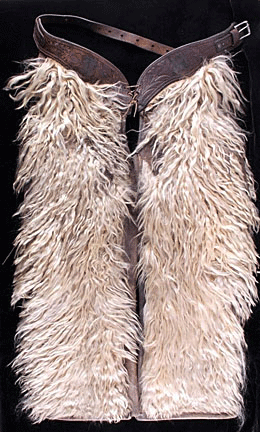 Shotgun
chaps were the plainest style of chaps. These seamless leather pants had
a shape that reminded one of a double-barreled shotgun, hence the name
"Shotgun Chaps. Typically they were held together by a belt that fit
straight across the waist and often were decorated along the outside
seam with long fringe. The chaps that didn't have a fringe were called
"closed-leg" chaps. This style was popular from the 1870's thru the
1890's and because of their skin-tight cut and design were hard to put
on or take off while wearing a pair of boots and spurs. Shotgun
chaps were the plainest style of chaps. These seamless leather pants had
a shape that reminded one of a double-barreled shotgun, hence the name
"Shotgun Chaps. Typically they were held together by a belt that fit
straight across the waist and often were decorated along the outside
seam with long fringe. The chaps that didn't have a fringe were called
"closed-leg" chaps. This style was popular from the 1870's thru the
1890's and because of their skin-tight cut and design were hard to put
on or take off while wearing a pair of boots and spurs.
Wooly chaps became popular in the late 19th century in the northern
plains, especially during cold and wet weather. They were made in a wide
variety of furs including bear and buffalo but the most prized was
Angora goat fur. These chaps were worn by not only cowboys in the far
northern states but Wild West performers who loved how "showy" they
were. The chaps were made from hides with the hair left on. Cowboys in
the far north in states like Montana and North Dakota wore these as the
hair repelled not only the rain and snow but kept the wearer warm and
comfortable even in the most torrential downpour or heavy snowstorm.
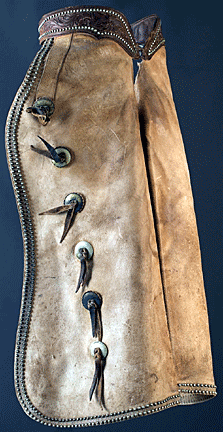 Batwing
chaps with bleedknots appeared in the early 20th century and gained
immediate acceptance because they had snap fasteners that allowed them
to go on and come off easily. Because of their design they were easy to
decorate and could be made extremely ornate. These pants had wide
leather wings which flapped freely instead of being tightly tied down.
In the western states cowboys would often unsnap their chaps to allow
for ventilation. This chap only buckled to the knee so the wearer could
easily bend his legs. This worked well when working on the range
especially when squatting down to tie off a cow for branding, as well as
working the rodeo arena. The wide wings were perfect for leather
tooling, overlay and inlay patterns of dyed leather, sharp-studded
designs and conchos. Saddle shops would offer custom designs with names,
initials, or anything else a cowboy might want. Batwing
chaps with bleedknots appeared in the early 20th century and gained
immediate acceptance because they had snap fasteners that allowed them
to go on and come off easily. Because of their design they were easy to
decorate and could be made extremely ornate. These pants had wide
leather wings which flapped freely instead of being tightly tied down.
In the western states cowboys would often unsnap their chaps to allow
for ventilation. This chap only buckled to the knee so the wearer could
easily bend his legs. This worked well when working on the range
especially when squatting down to tie off a cow for branding, as well as
working the rodeo arena. The wide wings were perfect for leather
tooling, overlay and inlay patterns of dyed leather, sharp-studded
designs and conchos. Saddle shops would offer custom designs with names,
initials, or anything else a cowboy might want.
Frisco oil-tanned cowhide chinks were most commonly used in the
southwest. Chinks were a half-length chap that attached at the waist and
ended just below the knee, usually with a very long fringe at the bottom
and along the sides which made them appear much longer than they are.
The cut was a cross between a batwing and shotgun and each leg usually
had two fasteners located high up on the thigh. These were cooler to
wear than a full length chap which is why southwestern cowboys not
riding through tough terrain preferred them.
Wrist Cuffs
These cuffs first appeared in photographs and saddle catalogs in the
1890's and are believed to have derived from the military style leather
gauntlet which was also worn by cowboys. The first cuffs tied around the
wrist with laces and they had two functions. One
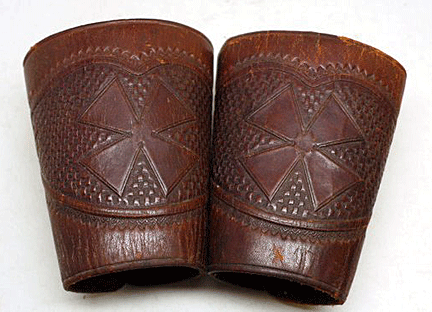 was
to protect the cuffs of the shirt which was the first part to wear out
on a store-bought shirt which at the time was expensive. Secondly, the
cuff protected a cowboy’s wrist from kicking hooves when branding
cattle, much as the high top boots protected the legs. These eventually
became a traditional cowboy accessory and "fashion statement." Earlier
ones had carving or stamped designs while later ones were decorated with
spots and conchos. Rodeo riders loved them because they added flash when
they were riding a bucking bronco or bull. was
to protect the cuffs of the shirt which was the first part to wear out
on a store-bought shirt which at the time was expensive. Secondly, the
cuff protected a cowboy’s wrist from kicking hooves when branding
cattle, much as the high top boots protected the legs. These eventually
became a traditional cowboy accessory and "fashion statement." Earlier
ones had carving or stamped designs while later ones were decorated with
spots and conchos. Rodeo riders loved them because they added flash when
they were riding a bucking bronco or bull.
Saddles
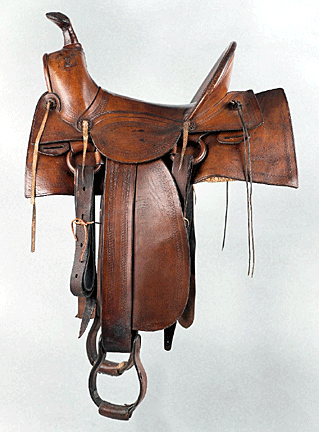 In
the west the saddle was not only a tool that was used everyday but a
symbol of stature. Many a cowboy didn't own their own horse, but if they
had their own saddle, they could get a job just about anywhere. An
average custom saddle in the 1870's could cost between $30 to $50 which
when you only earned a dollar a day was a huge investment. Most cowboys
considered their rig their most important possession and by taking
excellent care of a well made saddle it could last up to 20 years or
more. Over time the saddle was broken in to the riders shape, becoming
more comfortable and achieving the "rocking chair fit"....which made it
even more valuable considering the hours and days upon end spent sitting
on it. In
the west the saddle was not only a tool that was used everyday but a
symbol of stature. Many a cowboy didn't own their own horse, but if they
had their own saddle, they could get a job just about anywhere. An
average custom saddle in the 1870's could cost between $30 to $50 which
when you only earned a dollar a day was a huge investment. Most cowboys
considered their rig their most important possession and by taking
excellent care of a well made saddle it could last up to 20 years or
more. Over time the saddle was broken in to the riders shape, becoming
more comfortable and achieving the "rocking chair fit"....which made it
even more valuable considering the hours and days upon end spent sitting
on it.
The American stock saddle evolved from the from the early Spanish war
saddle used by the conquistadores. Mexican vaqueros adapted the original
saddle which had a heavy rigid tree, high fork and cantle, deep-dished
seat and short stirrups. They made a few minor modifications and added a
leather skirt. In the late 1700's the Mexican "California" saddle
appeared, and it had a fixed skirt which was round and without jockeys
along with a more substantial rigging which consisted of a cinch ring
that hung down in line with the front fork and a horizontal strap that
ran from the cinch to the back of the tree to secure the saddle. The
strong high-peaked pommels of this saddle were ideal for taking a turn
around a rope for holding an animal.
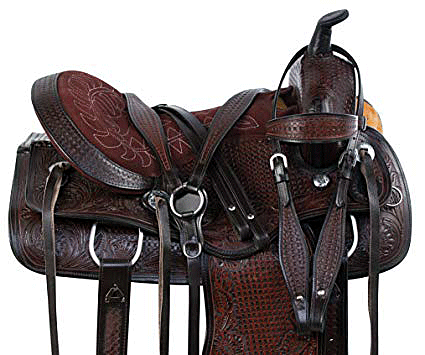 The
Texans altered the design even more. They liked the basic overall design
and kept the wooden tree, horn, cantle and stamped leather but they
modified the wooden horn so it was short, thick and covered in leather.
The skirt was changed to a plain square skirt and the stirrups were made
out of wide steam bent pieces of wood which were much stronger than the
carved ones previously used. A second cinch was also added to firmly
anchor the saddle as dealing with longhorn cattle were much different
than dealing with domesticated ones. In the 1870's they changed the horn
again to a short metal one as the wooden ones often broke when dealing
with a wild cow. The
Texans altered the design even more. They liked the basic overall design
and kept the wooden tree, horn, cantle and stamped leather but they
modified the wooden horn so it was short, thick and covered in leather.
The skirt was changed to a plain square skirt and the stirrups were made
out of wide steam bent pieces of wood which were much stronger than the
carved ones previously used. A second cinch was also added to firmly
anchor the saddle as dealing with longhorn cattle were much different
than dealing with domesticated ones. In the 1870's they changed the horn
again to a short metal one as the wooden ones often broke when dealing
with a wild cow.
By the late 1880s, the California saddle became the "classic cowboy
saddle." More elaborate in design because of the Spanish/Mexican
influence, they weren't designed to chase wild cattle like the "Texas"
saddle. It was more important to the Spanish ranchers that their tack be
elaborately tooled and engraved with silver which showcased their pride
in their horsemanship.
< Back
to Collectibles Archives
Next Article > |
